[Esp]Flexibilidad y alineación corporal./[Eng]Flexibility and body alignment.
Cuando los músculos, están en condiciones de realizar el mayor recorrido articular, contando con la flexibilidad necesaria para que puedan retornar a su posición inicial, se contribuye con una efectiva alineación corporal, es decir, lograr ubicar la cabeza, el torso y la pelvis, imaginariamente en una línea derecha, que comienza desde los pies y sale por la coronilla, permitiendo una buena postura, en ese sentido para alcanzar una adecuada flexiblidad y alineación corporal, permítanme recomendar el desarrollo de Urdha Hastasana o postura de la palmera y su variante, con flexión posterior del torso.
La nombrada postura y su variante, se realiza, estando parados, con la espalda derecha, flexionando suavemente el torso hacia atrás, llevando un brazo estirado a esa posición, mientras que el otro brazo lo bajamos, para apoyar la mano cercano a la corva de la pierna que está desplazada atrás, mientras mantenemos la otra pierna adelantada, es oportuno indicar, que al momento del desplazamiento de la pierna hacia atrás, la rodilla debe estar muy cercana a la rodilla de la otra pierna. La postura la palmera y su variante, además de contribuir a mantener un cuerpo flexible y alineado, permitiendo mejorar la postura, también generan un efectivo equilibrio y una adecuada relajación, asimismo permiten el estiramiento de los músculos abdominales, de la columna vertebral, los hombros, las piernas y los brazos, ayudan a mejorar los procesos respiratorios, alivian el dolor del nervio ciatico, disminuyen la ansiedad, mejoran el estrés y calman la mente. Esperando contar con el apoyo, en el desarrollo de tan importante asana y su variante, en beneficio de la salud física y mental, les deseo muchos éxitos.

When the muscles are in a position to carry out the greatest joint travel, with the necessary flexibility so that they can return to their initial position, an effective body alignment is contributed, that is, managing to locate the head, torso and pelvis, imaginarily in a straight line, which starts from the feet and goes out through the crown, allowing a good posture, in that sense to achieve adequate flexibility and body alignment, let me recommend the development of Urdha Hastasana or posture of the palm tree and its variant, with posterior flexion of the torso.
The aforementioned posture and its variant, is performed, standing, with the back straight, gently bending the torso backwards, bringing one arm outstretched to that position, while the other arm is lowered, to support the hand near the hamstring. the leg that is displaced behind, while we keep the other leg forward, it is opportune to indicate that at the moment of the displacement of the leg backwards, the knee must be very close to the knee of the other leg. The palm tree posture and its variant, in addition to helping to maintain a flexible and aligned body, allowing to improve posture, also generate an effective balance and adequate relaxation, also allow the stretching of the abdominal muscles, the spine, the shoulders, legs and arms, help improve respiratory processes, relieve sciatic nerve pain, reduce anxiety, improve stress and calm the mind. Hoping to have the support, in the development of such an important asana and its variant, for the benefit of physical and mental health, I wish you much success.
Proceso de Meditación
Es muy importante meditar, previo al proceso de calentamiento corporal, para relajarnos y calmar la mente, lo haremos aplicando la posición que se describe a continuación; sentados con la espalda derecha, las piernas flexionadas hacia delante, juntando las plantas de los pies, estiramos los brazos y colocamos en las rodillas las manos abiertas con las palmas hacia arriba, para reflexionar e interanalizar los siguientes pensamientos: "El optimismo es la esperanza que conduce hacia los logros" y "Una buena salud, es una de las mejores bendiciones de la vida". Éxitos.
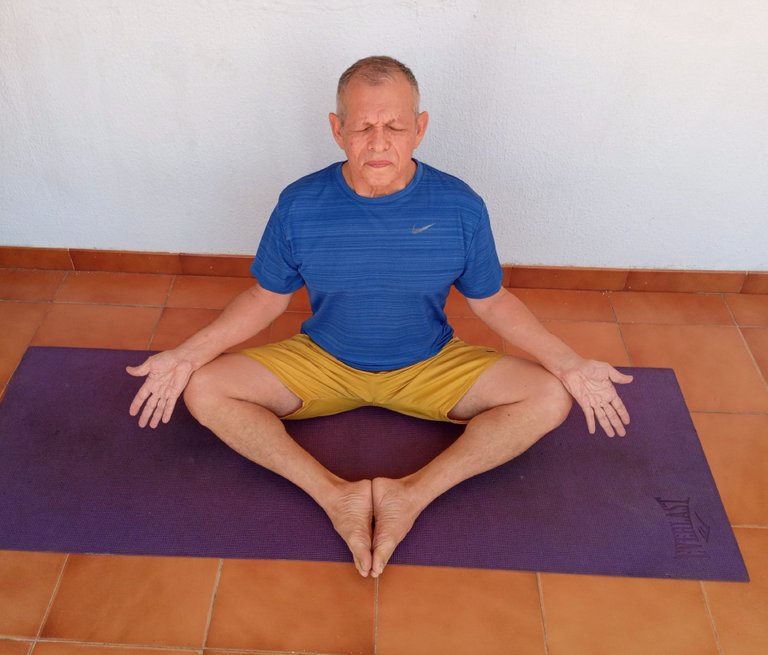
Meditation Process
It is very important to meditate, prior to the body warm-up process, to relax and calm the mind, we will do it by applying the position described below; Sitting with our back straight, legs bent forward, bringing the soles of our feet together, we stretch out our arms and place our open hands on our knees with the palms facing upwards, to reflect and internalize the following thoughts:"Optimism is hope that leads to achievement" and "Good health is one of life's greatest blessings". Successes.
Ejercicios para calentar el cuerpo
Con la finalidad de alcanzar un buen rendimiento, evitar lesiones, flexibilizar los músculos y articulaciones, calentaremos el cuerpo, con diversos ejercicios para equilibrarnos y fortalecer los músculos de la espalda, del abdomen y de las extremidades superiores e inferiores, ellos son:
Sentados en la esterilla con la espalda derecha, las piernas entrecruzadas, llevamos los brazos hacia arriba, entrelazamos los dedos de las manos y las colocamos en la nuca, luego giramos el torso a la izquierda y a la derecha, seguidamente flexionamos el torso hacia abajo, direccionando la frente a cada rodilla, durando 6 minutos de ejercicios, con 10 segundos de descanso por cada 2 minutos de calentamiento. Éxitos.
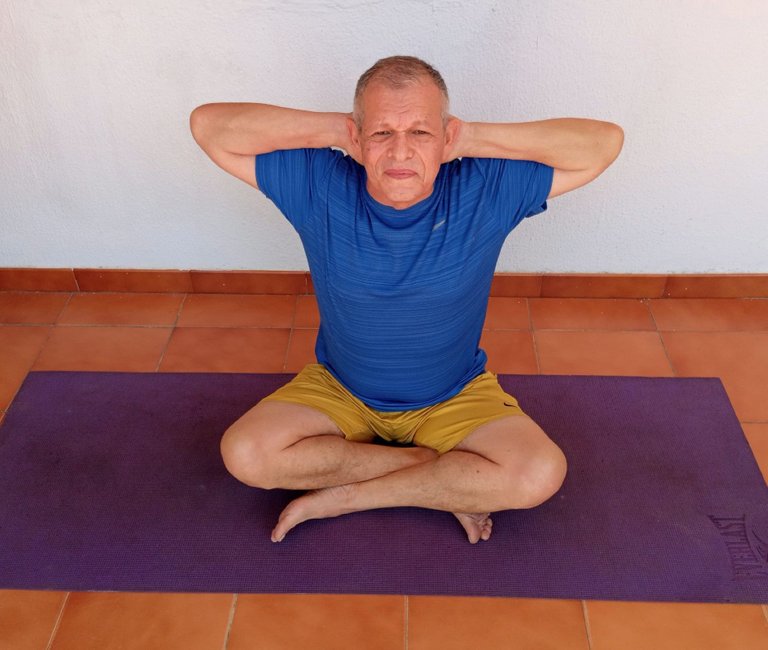
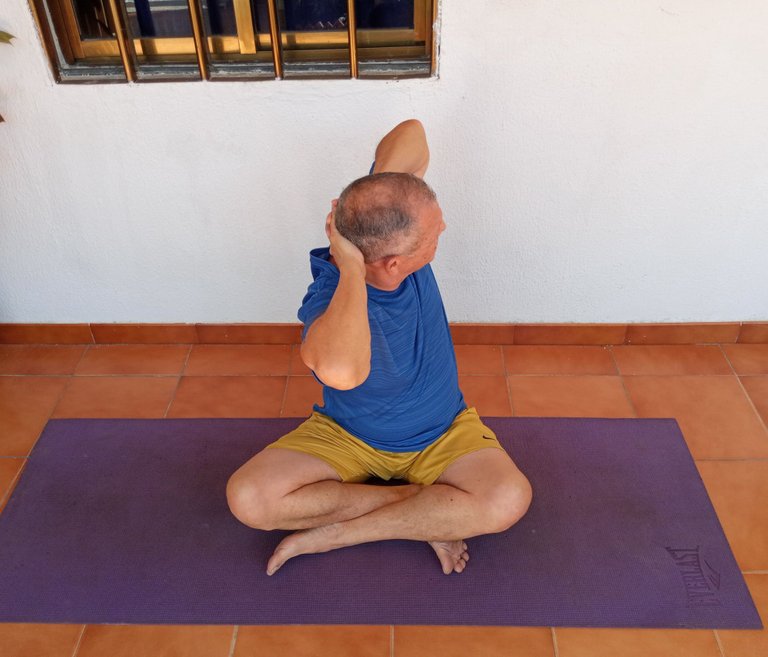
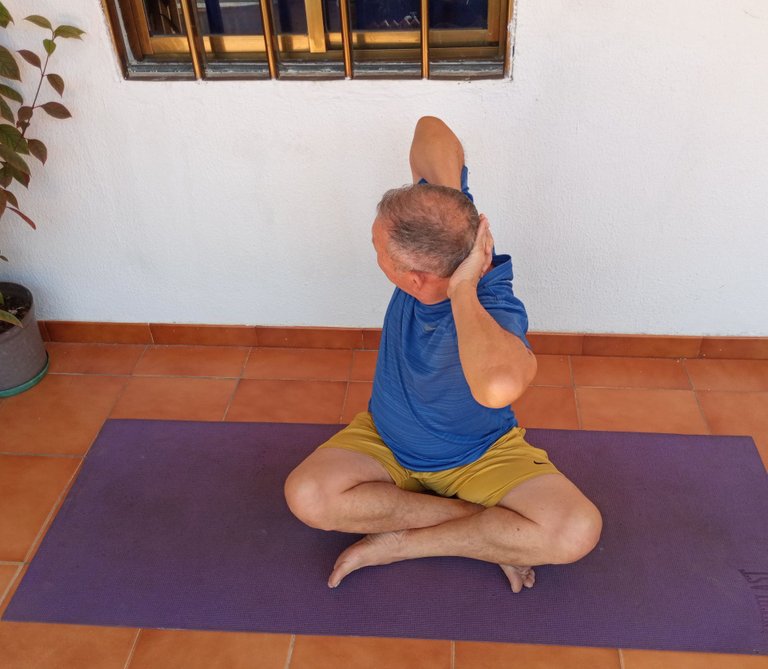
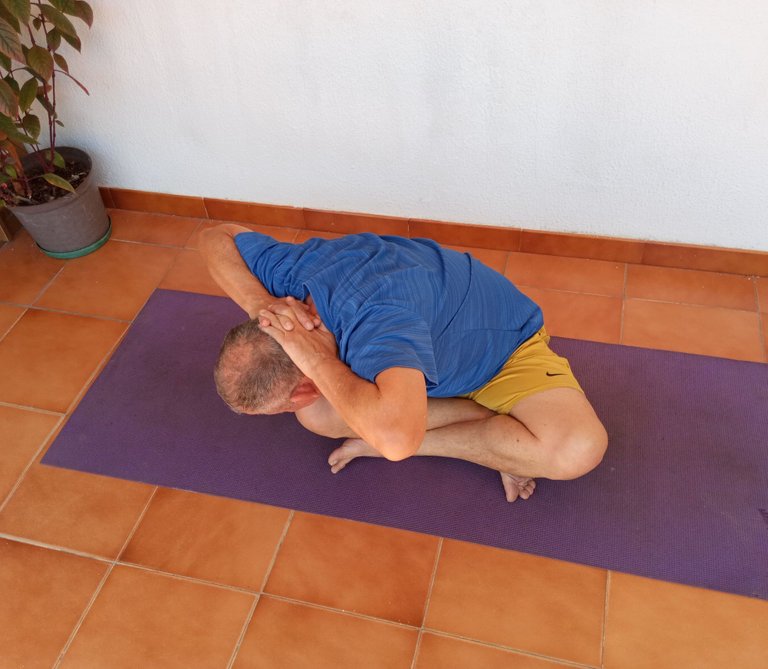
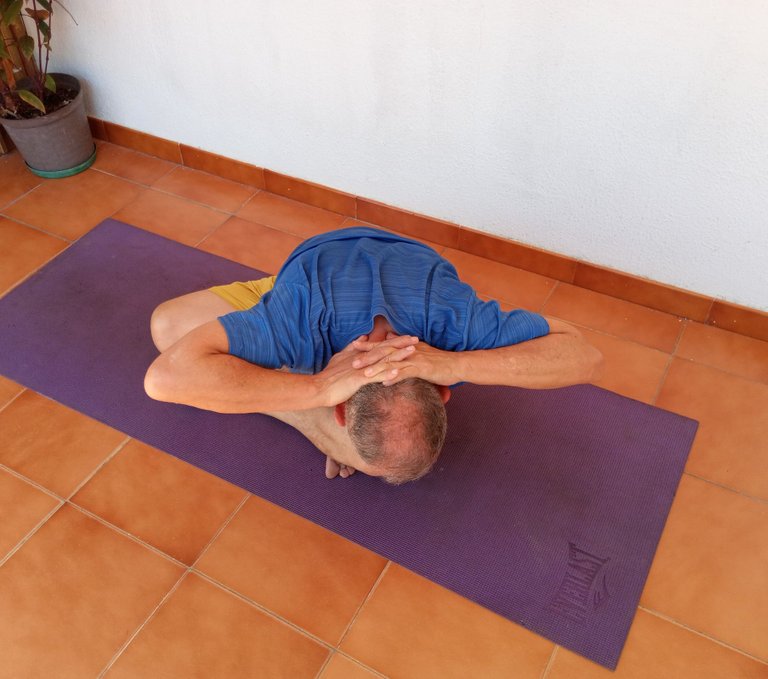
Exercises to warm up the body
In order to achieve good performance, avoid injuries, make muscles and joints more flexible, we will warm up the body, with various exercises to balance and strengthen the muscles of the back, abdomen and upper and lower extremities, they are: Sitting on the mat with our back straight, legs crossed, we bring our arms up, we interlock the fingers of our hands and place them on the back of the neck, then we turn the torso to the left and to the right, then we flex the torso downwards, directing the forehead to each knee, lasting 6 minutes of exercises, with 10 seconds of rest for every 2 minutes of warm-up. Successes.
Ubicados en la posición inicial, es decir sentados en la esterilla con la espalda derecha, las piernas entrecruzadas, flexionamos el torso lateralmente es decir a la izquierda, luego a la derecha, seguidamente llevamos el torso hacia atrás y hacia delante, durando 6 minutos de ejercicios, con 10 segundos de descanso por cada 2 minutos de calentamiento. Éxitos.
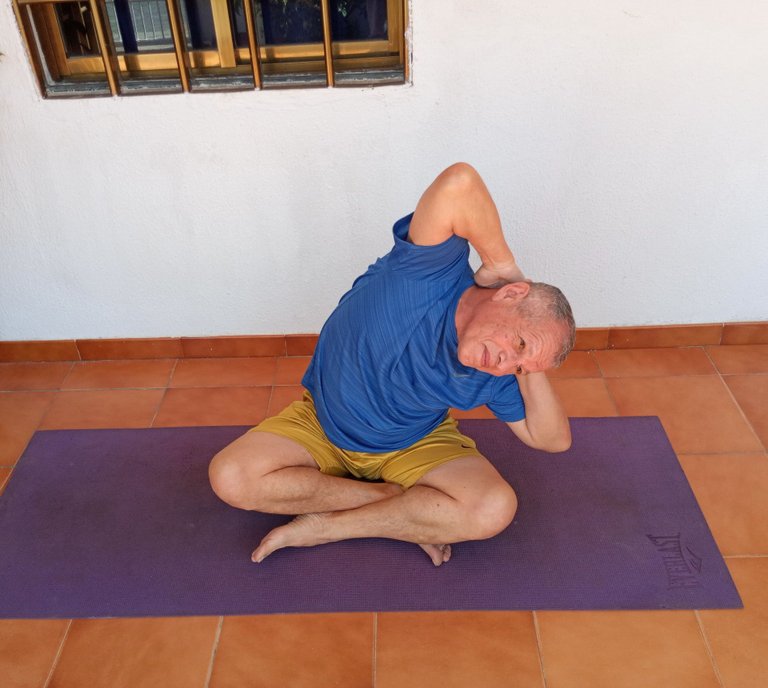
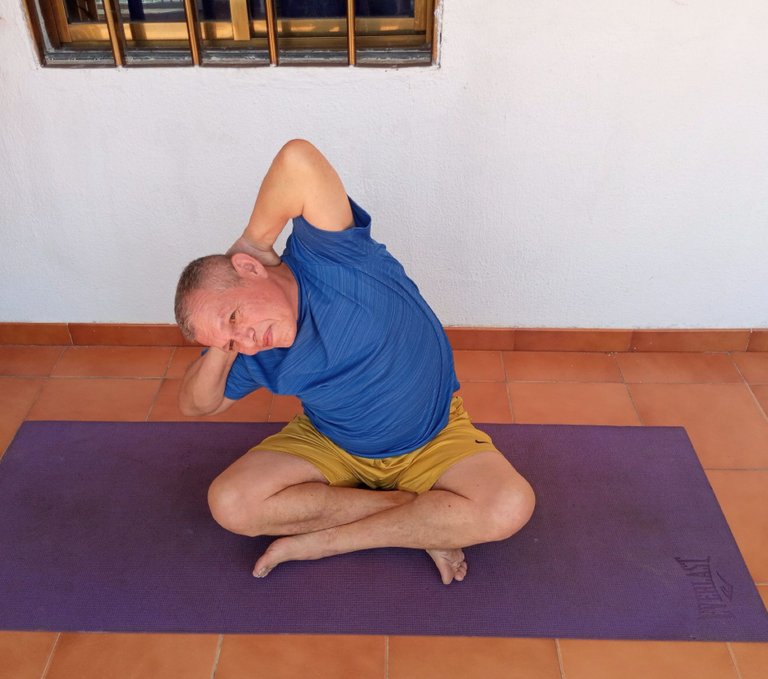

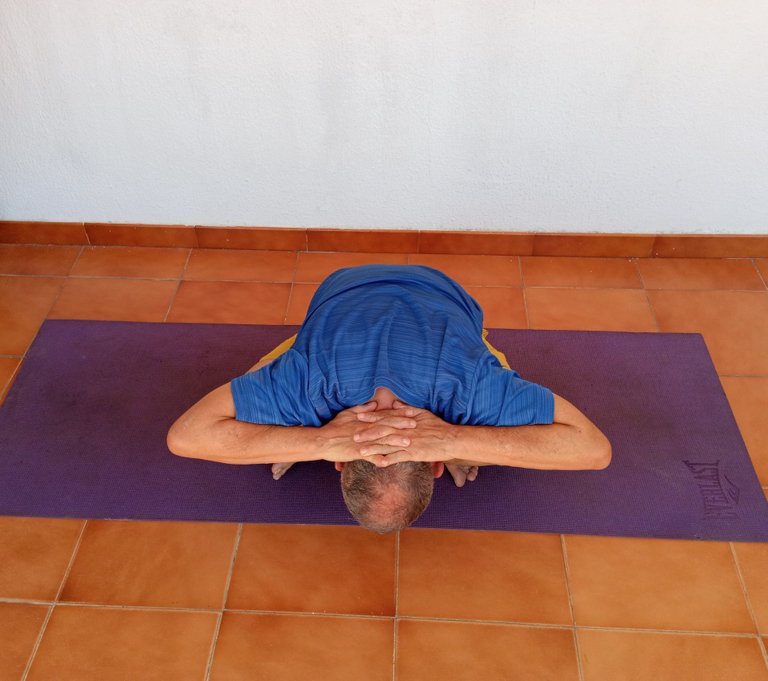
Located in the initial position, that is, sitting on the mat with the back straight, legs crossed, we flex the torso laterally, that is to say to the left, then to the right, then we take the torso backwards and forwards, lasting 6 minutes of exercises, with 10 seconds of rest for every 2 minutes of warm-up. Successes.
Desarrollo de Urdha Hastasana o postura de la palmera y su variante, con flexión posterior del torso; estando parados, con la espalda derecha, flexionando suavemente el torso hacia atrás, llevando un brazo estirado a esa posición, mientras que el otro brazo lo bajamos, para apoyar la mano cercano a la corva de la pierna que está desplazada atrás, mientras mantenemos la otra pierna adelantada
Ubicados en Tadasana o la postura de la montaña, con el cuerpo recto, las piernas juntas y los brazos a los lados, estiramos los brazos y los llevamos hacia arriba, juntando las palmas de las manos, en esta asana es muy bueno, desarrollarla durante 30 segundos para comenzar a estar equilibrados y alineados, percibiendo un efectivo estiramiento corporal, inspirando, aguantando y expulsando aire. Éxitos.
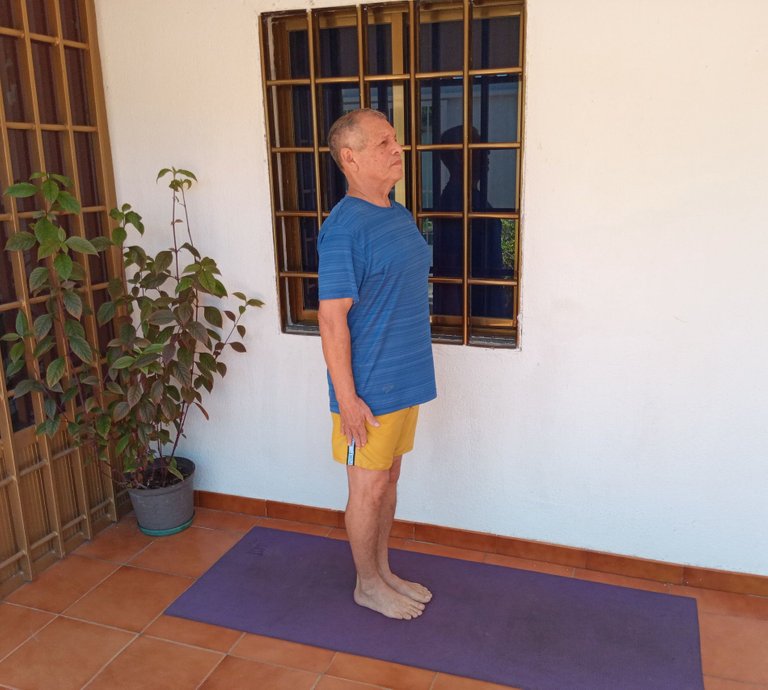
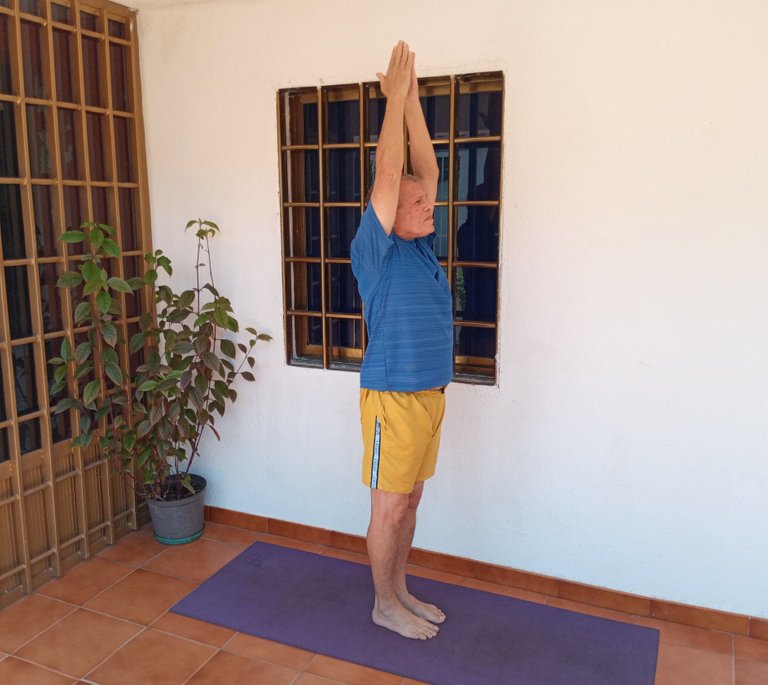
Development of Urdha Hastasana or posture of the palm tree and its variant, with posterior flexion of the torso; standing, with the back straight, gently bending the torso backwards, bringing one arm outstretched to that position, while the other arm is lowered, to support the hand close to the crook of the leg that is displaced behind, while maintaining the another leg forward
Located in Tadasana or the posture of the mountain, with the body straight, the legs together and the arms at the sides, we stretch the arms and bring them up, joining the palms of the hands, in this asana it is very good, to develop it during 30 seconds to begin to be balanced and aligned, perceiving an effective body stretch, inhaling, holding and expelling air. Successes.
Estando en la posición anterior, manteniendo los brazos extendidos hacia arriba, con las palmas de las manos juntas, suavemente sin hacer mucha tensión, conscientes de nuestra capacidad de flexibilidad, suavemente, sin hacer mucha tensión, doblamos el torso hacia atrás, durando igualmente 30 segundos, equilibrados y en resistencia corporal, inspiramos, aguantamos y expulsamos aire. Éxitos.
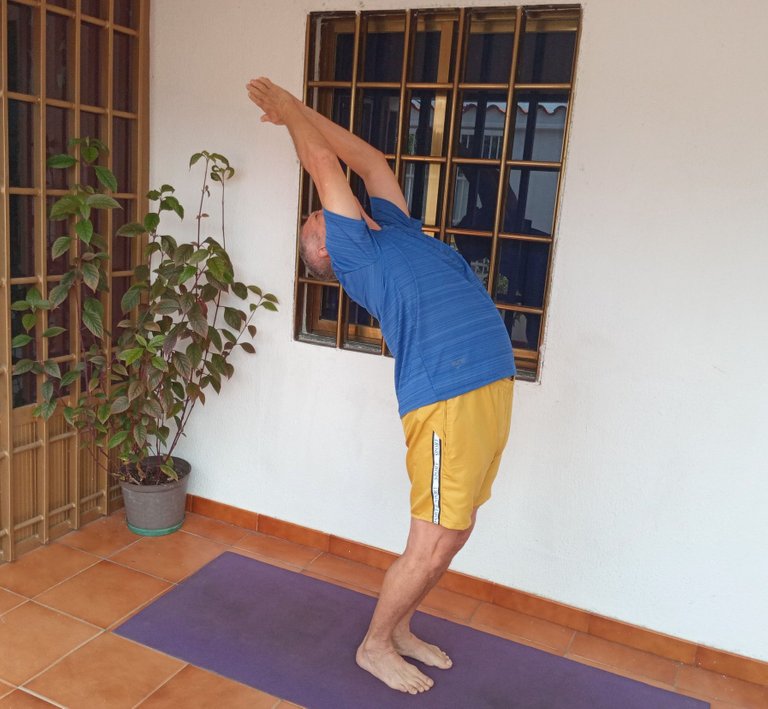
Being in the previous position, keeping the arms extended upwards, with the palms of the hands together, gently without making much tension, aware of our capacity for flexibility, gently, without making much tension, we bend the torso backwards, also lasting 30 seconds. seconds, balanced and in body resistance, we inspire, hold and expel air. Successes.
Conformamos Urdha Hastasana flexión posterior o la variante de la palmera, de la siguiente manera, estando con el torso flexionado hacia atrás, desplazamos el pie derecho a dicho lado, logrando que la rodilla de la pierna izquierda quede lo más cercano a la otra, seguidamente bajamos el brazo derecho hacia la pierna de ese lado, apoyando la mano detrás de la rodilla, es decir cercano a la corva, mientras dejamos el brazo izquierdo levantado y direccionado conjuntamente con la espalda, durando 30 segundos, equilibrados y en resistencia corporal, inspirando, aguantando y expulsando aire. Éxitos.
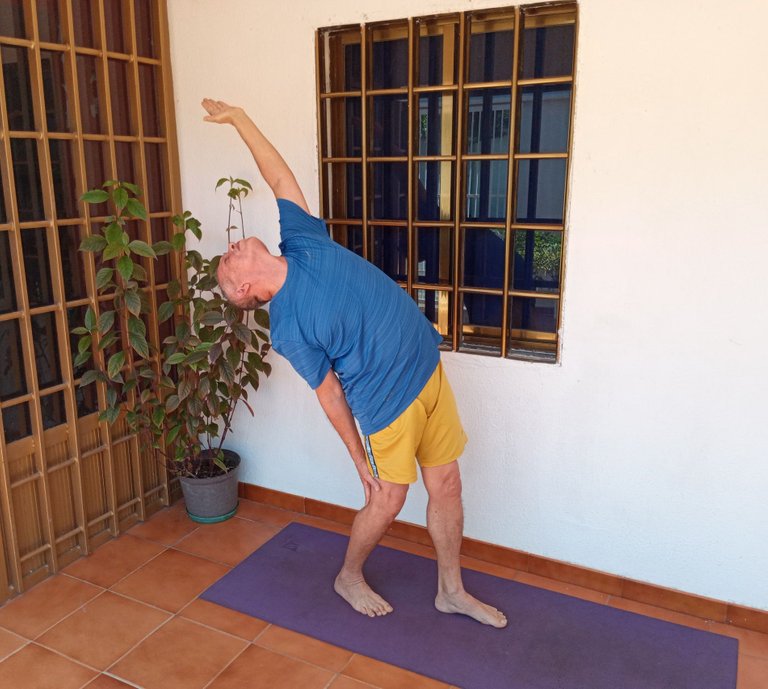
We form Urdha Hastasana posterior flexion or the variant of the palm tree, as follows, with the torso flexed backwards, we move the right foot to that side, making the knee of the left leg as close to the other, then we lower the right arm towards the leg on that side, supporting the hand behind the knee, that is, close to the hamstring, while we leave the left arm raised and directed together with the back, lasting 30 seconds, balanced and in body resistance, inhaling , holding and expelling air. Successes.
Repetimos la postura Urdha Hastasana, flexión posterior o la variante de la palmera, de la siguiente manera, ubicados en la asana la palmera, es decir, con el torso flexionado hacia atrás y los brazos extendidos hacia arriba, con las palmas de las manos juntas, en esta ocasión desplazamos el pie izquierdo a dicho lado, logrando que la rodilla de la pierna derecha quede lo más cercano a la otra, seguidamente bajamos el brazo izquierdo hacia la pierna de ese lado, apoyando la mano detrás de la rodilla, es decir cercano a la corva, mientras dejamos el brazo derecho levantado y direccionado conjuntamente con la espalda, durando 30 segundos, equilibrados y en resistencia corporal, inspirando, aguantando y expulsando aire. Éxitos.
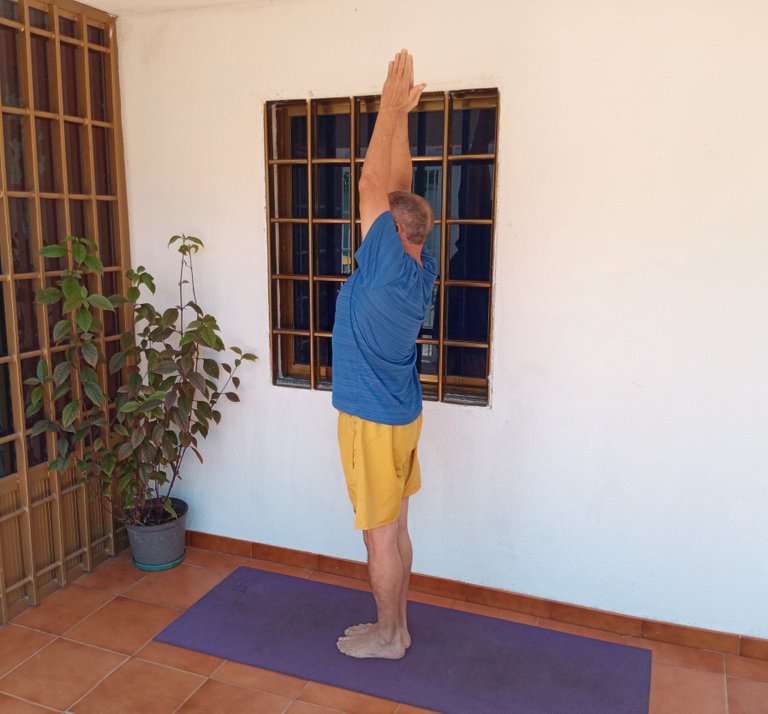
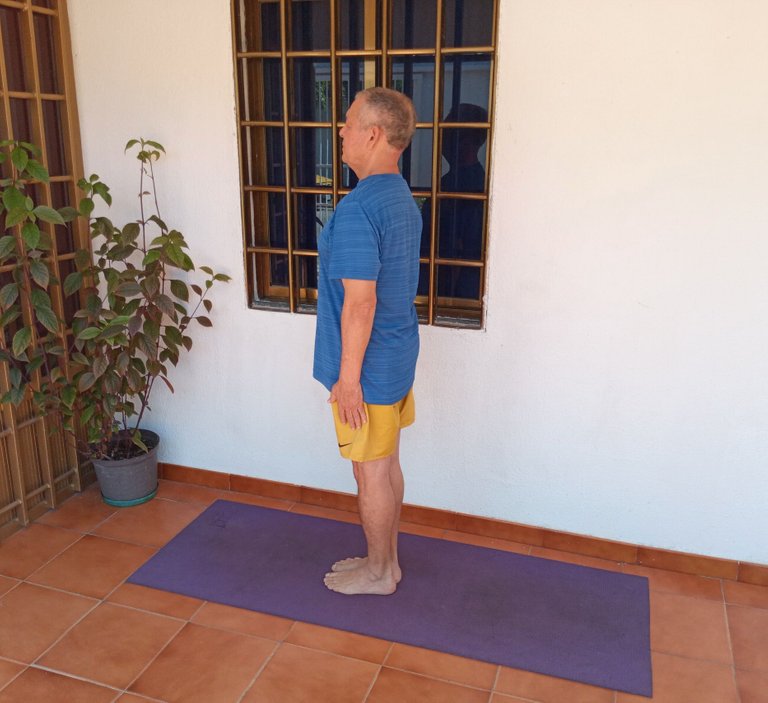
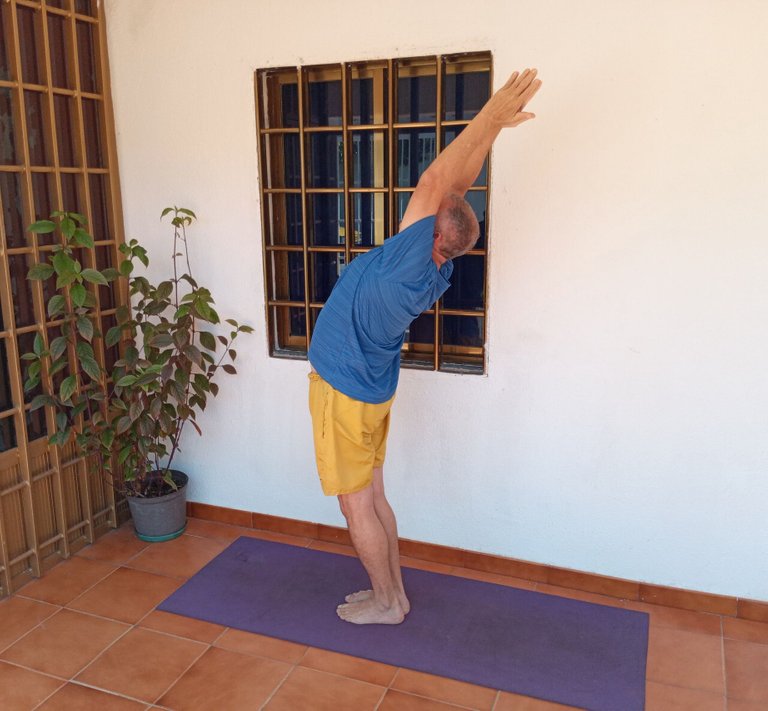
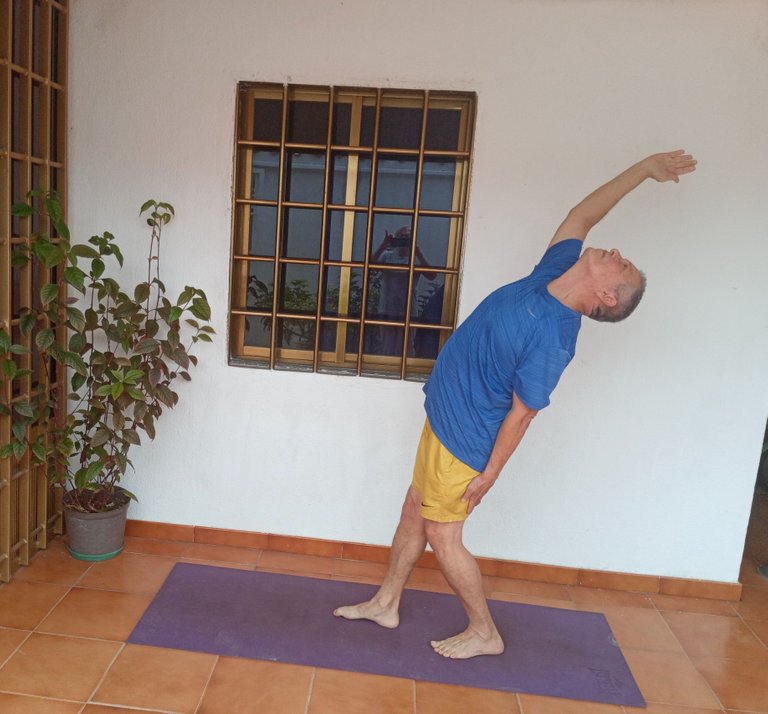
We repeat the posture Urdha Hastasana, posterior flexion or the variant of the palm tree, in the following way, located in the palm tree asana, that is, with the torso flexed backwards and the arms extended upwards, with the palms of the hands together , this time we move the left foot to that side, ensuring that the knee of the right leg is as close to the other, then we lower the left arm towards the leg on that side, supporting the hand behind the knee, that is close to the hamstring, while we leave the right arm raised and directed together with the back, lasting 30 seconds, balanced and in body resistance, inhaling, holding and expelling air. successes.
Es oportuno expresar, que de no lograr quedarnos equilibrados, mientras mantenemos el torso flexionado hacia atrás, al colocar una de las manos en el muslo cercano a la corva, podemos ubicarla al lado del citado muslo de la pierna doblada, conforme se evidencia en la siguiente imagen, recordando que la práctica del yoga es para sanarnos física y mentalmente, nunca es para maltratar el cuerpo. Éxitos.

It is opportune to express that if we are not able to stay balanced, while keeping the torso flexed backwards, by placing one of the hands on the thigh close to the hamstring, we can place it next to the aforementioned thigh of the bent leg, as evidenced in the following image, remembering that the practice of yoga is to heal us physically and mentally, it is never to mistreat the body. Successes.
Beneficios de Urdha Hastasana o postura de la palmera y su variante, flexión posterior del torso; estando parados, con la espalda derecha, flexionando suavemente el torso hacia atrás, llevando un brazo estirado a esa posición, mientras que el otro brazo lo bajamos, para apoyar la mano cercano la corva de la pierna que está desplazada atrás, mientras mantenemos la otra pierna adelantada
- Contribuyen a mantener un cuerpo flexible y alineado.
- Permiten mejorar la postura.
- Generan un efectivo equilibrio y una adecuada relajación corporal.
- Dicha asana y su respectiva variante, permiten el estiramiento de los músculos abdominales, de la columna vertebral, los hombros, las piernas y los brazos.
- Ayudan a mejorar los procesos respiratorios.
- Son muy buenas para aliviar el dolor del nervio ciatico.
- Son efectivas para disminuir la ansiedad, mejorar el estrés y calmar la mente.
Benefits of Urdha Hastasana or palm tree pose and its variant, posterior flexion of the torso; standing, with the back straight, gently bending the torso backwards, bringing one arm outstretched to that position, while the other arm is lowered, to support the hand near the crook of the leg that is displaced behind, while keeping the other lead leg
- Contribute to maintaining a flexible and aligned body.
- Allow to improve posture.
- They generate an effective balance and proper body relaxation.
- This asana and its respective variant, allow the stretching of the abdominal muscles, the spine, the shoulders, the legs and the arms.
- Help improve respiratory processes.
- They are very good for relieving sciatic nerve pain.
- They are effective in reducing anxiety, improving stress and calming the mind.
Urdha Hastasana o postura de la palmera y su variante, también denominada flexión posterior del torso, las cuales se realizan, estando parados, con la espalda derecha, flexionando suavemente el torso hacia atrás, llevando un brazo estirado a esa posición, mientras que el otro brazo lo bajamos, para apoyar la mano cercano a la corva de la pierna que está desplazada atrás, mientras mantenemos la otra pierna adelantada, son muy buenas por su contribución en el mantenimiento de un cuerpo flexible y alineado, permitiendo mejorar la postura, también por generar un efectivo equilibrio y una adecuada relajación corporal, otro de sus destacados beneficios es la de permitir el necesario e importante estiramiento de los músculos abdominales, de la columna vertebral, los hombros, las piernas y los brazos, asimismo por la gran ayuda en el mejorarñmiento de los procesos respiratorios, aliviar el dolor del nervio ciatico, disminuir la ansiedad, mejorar el estrés y calmar la mente. En síntesis, las practicadas posturas son muy esenciales para la salud, por ello me complace, una vez más, reiterarles la invitación, para que juntos desarrollemos las anunciadas asanas, lógicamente con sus procesos anteriores de meditación y calentamiento corporal. Amigos, al agradecerles su receptividad y constantes visitas, me suscribo a ustedes, con mucho afecto. Omar Gustavo Rojas Ortiz desde la ciudad de Cumaná en el estado Sucre-Venezuela.
Urdha Hastasana or posture of the palm tree and its variant, also called posterior flexion of the torso, which are performed, while standing, with the back straight, gently bending the torso backwards, bringing one arm outstretched to that position, while the other arm we lower it, to support the hand close to the crook of the leg that is displaced behind, while we keep the other leg forward, they are very good for their contribution in maintaining a flexible and aligned body, allowing to improve posture, also for generate an effective balance and adequate body relaxation, another of its outstanding benefits is that of allowing the necessary and important stretching of the abdominal muscles, the spine, the shoulders, the legs and the arms, also for the great help in the improvement of respiratory processes, relieve sciatic nerve pain, reduce anxiety, improve stress and calm the mind. In short, the postures practiced are very essential for health, which is why I am pleased, once again, to reiterate the invitation, so that together we develop the announced asanas, logically with your previous processes of meditation and body warm-up. Friends, in thanking you for your receptivity and constant visits, I subscribe to you, with great affection. Omar Gustavo Rojas Ortiz from the city of Cumaná in the state of Sucre-Venezuela.
Las imágenes fueron tomadas por Nancy de Rojas con mi celular Samsung Galaxy A10s y la publicación es de mi autoría.
The images were taken by Nancy de Rojas with my Samsung Galaxy A10s cell phone and the publication is my own.
Portada editada en Canva
Cover edited in Canva
Logos propiedad de @hiveio, @fulldeportes
Logos owned by @hiveio, @fulldeportes
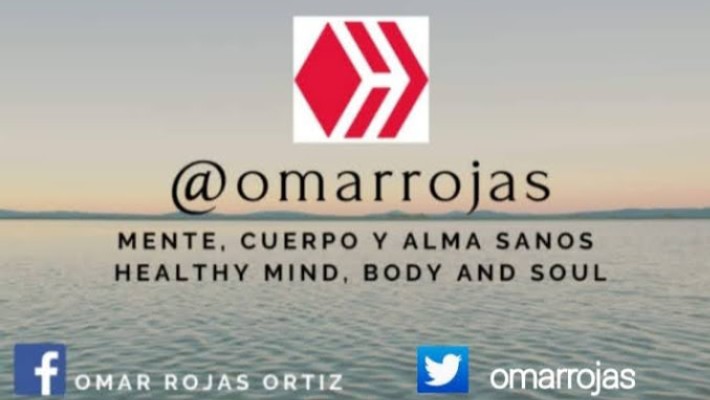
https://twitter.com/1325256276704686082/status/1590744640776712193
The rewards earned on this comment will go directly to the people sharing the post on Twitter as long as they are registered with @poshtoken. Sign up at https://hiveposh.com.
Congratulations @omarrojas! You have completed the following achievement on the Hive blockchain and have been rewarded with new badge(s):
Your next target is to reach 3250 replies.
You can view your badges on your board and compare yourself to others in the Ranking
If you no longer want to receive notifications, reply to this comment with the word
STOPCheck out the last post from @hivebuzz:
Support the HiveBuzz project. Vote for our proposal!
Estos ejercicios de elongación y posturas son muy buenas para mantener la movilidad del cuerpo , ya quisiera llegar yo a mis 50 y 60 con tu movilidad, te admiro!
Gracias estimado @malos10 dichos ejercicios y prácticas de yoga son especiales para una columna vertebral, que ayude a mantener el cuerpo derecho y con una adecuada postura. Las elongaciones de los músculos y articulaciones, son muy buenas también para un torso fuerte. Gracias por su visita.
Está súper esa rutina,la alineación corporal se ve como algo muy relajante
Así es estimado @blas-training ejercitarnos debe tener un importante propósito de relajación. Gracias por su visita.
Precioso post amigo!! Lo disfruté muchísimo! Como siempre calmo y entregado a la práctica del Yoga! Muchas gracias por compartir tu energía y posturas con todos nosotros. Esta vez te seguiré en esta práctica, ya que estoy con una contractura en el esternocleidomastoideo y estos movimientos permitirán activar mi cuerpo, en especial mi columna, de manera integral para liberar tensión.
Un fuerte abrazo amigo!!
Amen amiga @belug , es lo que más deseo de ti, que puedas mantener tu cuerpo flexible y con una efectiva alineación, dos aspectos bien importantes para estar con una buena postura muy equilibrada. Te deseo lo mejor. Gracias por tus educativas visitas. Éxitos
Gracias amigo! Saludos y éxitos!!